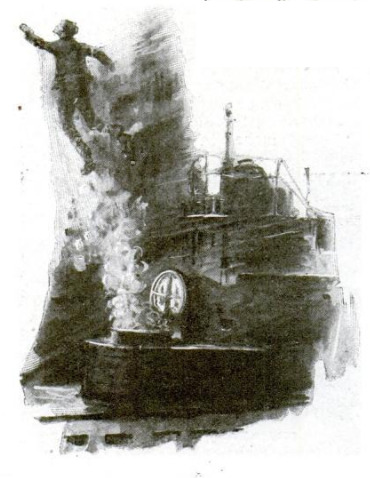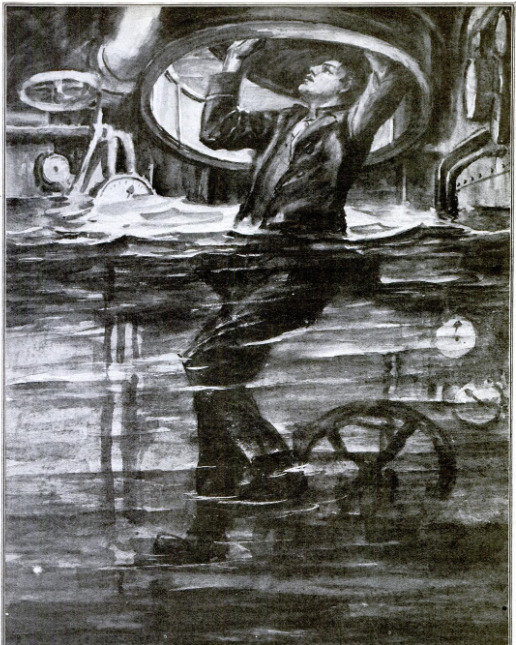-
Titolo
-
How a British sailor managed to escape from a sunking submarine
-
Article Title and/or Image Caption
-
Title: Trapped in a Sunken Submarine
-
Subtitle: Tons of water pressed down on the hatch. How could he escape? Recollection of an old physics lesson saved him from death
-
extracted text
-
THIS is the story of a
restless English
schoolboy who lis-
tened wearily as his teacher
talked Boyle's Law and
Archimedes’ Principle. What was
Boyle or the laws that gases and
liquids under pressure obey to him?
The time came, ten years later,
when they meant life or death to him.
It happened during the war, when he
was one of the crew of a British
submirine.
Highoat was lying idly on the surface
of the water. All the officers and crew
except himself were enjoying a holiday
ashore. He went below to work in the
engine-room, and left the conning-
tower hatch open. Then something
happened —the young man never knew
just what —and the boat lurched down
by the bow.
He thought of the conning-
tower hatch, and rushed forward
to close it. But the water was
already pouring in with such
force that he was unable to
accomplish his purpose. He re-
turned aft to the engine-room,
and locked himself in by means
of a water-tight door which
separated the boat into two
compartments.
In Complete Darkness
He was safe temporarily, but
the other half of the boat was
filling with water, and the sub-
marine was sinking lower and
lower.
The engine-room was in com-
plete darkness, due to the short-
circuiting of the clectric system.
Everything he touched shocked
him.
The salt water on the storage
batteries generated suffocating
chlorine gas. He rushed blindly
at the engine-room hatch and
tried to force it open. But his
strength was no match for the
pressure of the water outside;
and, even if he had been able
to open it, he would have been no
better off, for the water would have
rushed in and drowned him before he
could possibly get out.
He Reviews His Past
Realizing that his last chance was
gone, he grew quite calm, and, as is
the custom of dying folk, reviewed
the things he had done and those he
ought not to have done while here on
earth.
As he came to that day in school
‘when he unwillingly learned of pres-
sure, he stopped. Water, gas, pressure
what about them ?
He Remembered That Lesson
Then he remembered that, in the
case of a body submerged in water, the
combined force of the gas within and
the strength of the body material
must equal the force of the water
without, or the water would crush
the body in. Just so the combined
force of the air in the submarine and
the steel of the hatch equaled the force
of the water pressing down on it. If
he could make the force of the air in
the boat equal to the pressure of the
water on the boat, then the hatch
would be relieved of the strain of
holding off the water, and would
be easily lifted.
How could he increase the force of
the air? Then he thought of Boyle's
Law, which he had been forced to
memorize on that long-ago school-day
the volume of a gas varies inversely
with its pressure. If he decreased the
volume of the gas in the submarine,
he might increase the pressure enough
to make it equal that of the water.
This done, the hatch would be in equi-
librium and consequently
easily moved.
His next problem was
how to decrease the volume
of the air. There was only
one way to do this-— by letting the
water in. If he did that he would be
taking a last desperate chance; for he
did not know how much compressing
the air needed before it would exert a
force equal to that of the water outside.
If this failed him, he would drown
without a doubt.
Taking a Desperate Chance
He decided to take the chance. So,
groping inthe dark, he opened the bilge-
valve and let the water in. As it
crept up about his waist he philo-
sophically decided that he would
much rather drown than suffo- |
cate, anyway. But when it |
reached his waist he grew some- |
what nervous and thought he'd |
better try the hatch. |
He pushed against it, and it
opened slightly; but it slammed
shut again, crushing his fingers,
for the pressure of the air was
not yet great enough to resist
the water without the aid of the
hatch.
Nursing his injured fingers,
he waited stoically until the
water in the engine-room reached
the hatch coaming. Then, with
just his head above water, his
ear-drums strained from the
compressed air, he made a final
attempt to raise the unwilling
hatch. |
His patience, bravery, and cool- |
headedness were rewarded. At
last the air was compressed
enough to equal the force of
the water, and the hatch moved |
easily.
Physics Sees Him Through
After helping him thus far,
physics decided to see him
through. The compressed air
in the submarine repelled the water
which was trying hard to pour in
and drown him. The air shot up-
ward with great force, taking the
sailor along with it to the surface
of the water leaving him there,
breathless.
After he had righted himself and
shaken the water from his eyes, he
looked about and saw, a little dis-
tance away, a friendly destroyer, which
soon picked him up.
Such an experience must surely
force on any man a great respect for
school, teachers — and fate.
-
Autore secondario
-
Joseph Brinker (Article writer)
-
Lingua
-
eng
-
Data di rilascio
-
1919-03
-
pagine
-
28-29
-
Diritti
-
Public Domain (Google digitized)
-
Archived by
-
Davide Donà
-
Marco Bortolami (editor)



